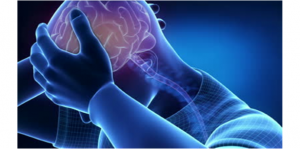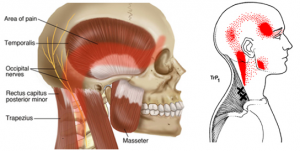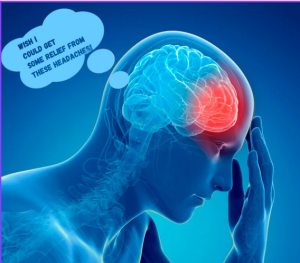Cervicogenic Headaches: When your neck is the source of the pain, Osteopractic Physical Therapy is the solution!

Cervicogenic Headaches (CGH) are 1 of the 14 classifications of headache, as recognized by the international Headache Society, falling under the secondary headache subcategory (meaning something else is causing the headache) and account for 15-20% of all chronic and recurrent headaches. Often, these types of headaches go undiagnosed, and are mistaken as migraines because their symptom presentation is similar. There is also the possibility of a mixed headache which has components of CGH as well as migraines or even tension type headaches.
- The International Headache Society describes CGH as “pain referred from a source in the neck and perceived in one or more regions of the head and/or face”( IHS classification ICHD-II, 2015)
- Symptoms of Cervicogenic headache may include: nausea, phonophobia (sensitivity to sound), photophobia (sensitivity to light), dizziness, blurred vision, swallowing difficulties, or swelling/pressure around the eye.
Diagnosis:
- Clinical diagnosis of CGH involves inclusion of the following characteristics:
- 1. One sided head pain without changing sides within an episode of headache pain,
- 2. Restricted motion of the upper neck joints, just below the skull,
- 3. Reproduction of symptoms with external pressure to same side upper, back part of the neck.
- 4. Headaches are brought on or increased with head/neck motion or activity.
- Your diagnosis:
- You find yourself trying to stretch your neck because it’s stiff when you get headaches, or pushing on the upper part just under your skull because it just seems like the right thing to do!
- The pain wraps from the back of your head and your eye feels like the pressure is going to make it explode.
Pain referral patterns:
How does your neck cause headaches?
As the picture shows, there is a direct neurologic link between the pain fibers from the upper part of the neck and the trigeminal nerve. The trigeminal ner ve is responsible for all sensation of the head and face and originates, in a structure called the trigeminocervical nucleus (TCN) in the brainstem.
ve is responsible for all sensation of the head and face and originates, in a structure called the trigeminocervical nucleus (TCN) in the brainstem.
The pain signals from the upper part of the neck converge with the signals going to the TCN and get interpreted as head pain, most commonly above and around the eye. As you can see in the picture there are branches of the trigeminal nerve that go to the cheek, jaw and chin, which explains the occasional jaw and face pain associated with these types of headaches. The pain information from the neck can originate from many different structures, with the most common sources being: the joints of the spine, the muscles attached to these joints, the discs, the ligaments and connective tissues, or the blood vessels in the area.
How Can Physical Therapy Help?
- There are a variety of different physical therapy treatments out there that have been shown to decrease and sometimes completely eliminate duration, frequency and intensity of headache symptoms by addressing the limitations in neck joint mobility, muscle tension, range of motion and weakness in postural muscles.
- These treatments include
- Manual therapy: massage, stretching, joint mobilization, high velocity low amplitude thrust manipulation (HVLAT) and dry needling with and without electric stimulation.
- Modalities: moist heat, electric stimulation
- Exercise: strengthening neck, shoulder and upper back muscles to help with posture and tension in the neck and base of the skull.
- These treatments include
- If have dealt with your headaches long enough, schedule an appointment and find out for yourself how effective Osteopractic Physical Therapy is!
Dr. Philip Denema, PT, DPT, ATC, FAAOMPT, Dip. Osteopractic, Cert. SMT, Cert. DN.


 Our
Our